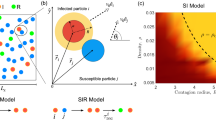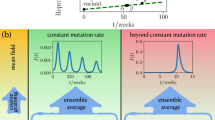Abstract
In this paper, we present an enhanced massively multi-agent system based on the previous MMAS for discovering the unique dynamics of HIV infection [1]. The enhanced MMAS keeps the spacial characteristics of cellular automata (CA), and employs mathematical equations within sites. Furthermore, new features are incorporated into the model, such as the sequence representation of HIV genome, immune memory and agent remote diffusion among sites. The enhanced model is closer to the reality and the simulation captures two extreme time scales in the typical three stages dynamics of HIV infection, which make the model more convincing. The simulation also reveals two phase-transitions in the dynamics of the size of immune memory, and indicates that the high mutation rate of HIV is the fatal factor with which HIV destroys the immune system eventually. The enhanced MMAS provides a good tool to study HIV drug therapy for its characterizing the process of HIV infection.
Preview
Unable to display preview. Download preview PDF.
Similar content being viewed by others
References
Zhang, S., Liu, J.: A Massively Multi-agent System for Discovering HIV-immune Interaction Dynamics. In: Ishida, T., Gasser, L., Nakashima, H. (eds.) MMAS 2005. LNCS (LNAI), vol. 3446, pp. 161–173. Springer, Heidelberg (2005)
Young, J.A.T.: The Replication Cycle of HIV-1. HIV InSite Knowledge Base Chapter (1997), http://hivinsite.ucsf.edu/InSite.jsp?page=kb-02&doc=kb-02-01-01
Hope, T.J., Md, D.T.: Structure, Expression, and Regulation of the HIV Genome. HIV InSite Knowledge Base Chapter (2000), http://hivinsite.ucsf.edu/InSite.jsp?page=kb-02&doc=kb-02-01-02
Pandey, R.B.: A Stochastic Cellular Automata Approach to Cellular Dynamics for HIV: effect of viral mutation. Theory in Bioscience 117, 32 (1998)
Mannion, R., Ruskin, H., Pandey, R.B.: Effect of Mutation on Helper T-cells and Viral Population: A Computer Simulation Model for HIV. Theory in Bioscience 119, 10 (2000)
Mannion, R., Ruskin, H., Pandey, R.B.: A Monte Carlo Approach to Population Dynamics of Cell in an HIV Immune Response Model. Theory in Bioscience 119, 94 (2000)
Mielke, A., Pandey, R.B.: A Computer Simulation Study of Cell Population in a Fuzzy Interaction model for Mutating HIV. Physica A 251, 430 (1998)
Pandey, R.B., Mannion, R., Ruskin, H.: Effect of Cellular Mobility on Immune Response. Physica A 283, 447 (2000)
Santos, R., Coutinho, S.: On the Dynamics of the Evolution of HIV Infection (2000), http://arxiv.org/abs/cond-mat/0008081
Santos, R., Countinho, S.: Dynamics of HIV infection: a cellular automata approach. Physical Review Letters 16, 0168102 (2001)
Hershberg, U., Louzoun, Y., Atlan, H., Solomon, S.: HIV Time Hierarchy: Winning the War while, Loosing all the Battles. Physica A 289, 178–190 (2000)
Kamp, C., Bornholdt, S.: From HIV infection to AIDS: A Dynamically Induced Percolation Transition? Proc. R. Soc. London B 269, 2035 (2002)
Kamp, C., Bornholdt, S.: Co-evolution of Quasispecies: B-cell Mutation Rates Maximize Viral Error Catastrophes. Physical Review Letters 88, 068104 (2002)
Kirschner, D.E.: Using Mathematics to Understand HIV Immune Dynamics. Notices of the American Mathematical Society, 191–202 (1996)
Kirschner, D.E., Mehr, R., Perelson, A.S.: Role of the Thymus in Pediatric HIV-1 Infection. Journal of Acquired Immune Deficiency Syndromes and Human Retrovirology 18, 95–109 (1998)
Kirschner, D.E., Webb, G.F.: A Mathematical Model of Combined Drug Therapy of HIV Infection. Journal of Theoretical Medicine 1, 25–34 (1997)
Hraba, T., Dolezal, J.: A Mathematical Model and CD4+ Lymphocyte Dynamics in HIV Infection. Emerging Infectious Diseases 2(4), 301–305 (1996)
Manrubia, S.C., Delgado, J., Luque, B.: Small-world Behavior in a System of Mobile Elements. Europhysics Letters 53, 693–699 (2001)
Sloot, P., Chen, F., Boucher, C.: Cellular Automata Model of Drug Therapy for HIV Infection. In: Bandini, S., Chopard, B., Tomassini, M. (eds.) ACRI 2002. LNCS, vol. 2493, pp. 282–293. Springer, Heidelberg (2002)
Author information
Authors and Affiliations
Editor information
Editors and Affiliations
Rights and permissions
Copyright information
© 2005 Springer-Verlag Berlin Heidelberg
About this paper
Cite this paper
Zhang, S., Yang, J., Wu, Y., Liu, J. (2005). An Enhanced Massively Multi-agent System for Discovering HIV Population Dynamics. In: Huang, DS., Zhang, XP., Huang, GB. (eds) Advances in Intelligent Computing. ICIC 2005. Lecture Notes in Computer Science, vol 3645. Springer, Berlin, Heidelberg. https://doi.org/10.1007/11538356_102
Download citation
DOI: https://doi.org/10.1007/11538356_102
Publisher Name: Springer, Berlin, Heidelberg
Print ISBN: 978-3-540-28227-3
Online ISBN: 978-3-540-31907-8
eBook Packages: Computer ScienceComputer Science (R0)




